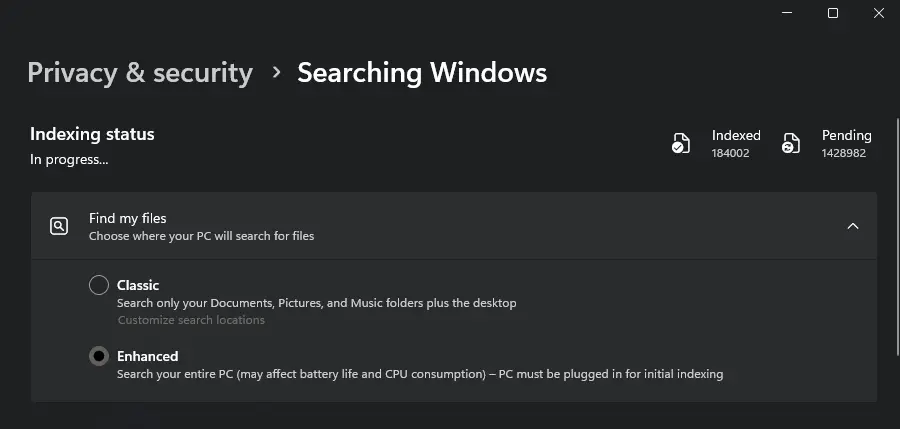This article explains how to tweak Windows Search so that it finds something. Or better yet – that it finds even the files that your applications are trying to HIDE from you (by storing your personal files under Application Data folder)!
Microsoft is actively trying to hide these files from you, and for a reason. You should store functional files (like cache) inside %AppData%, not the user’s personal documents. You shouldn’t, by default, mess with these functional files, and you shouldn’t need to find them either.
But alas, some software vendors (like NetSpot – I’m looking at you) like to force you to live on the edge – and store all of your personal files, projects and creations under %AppData%, where they’ll be nuked whenever a Windows update goes sideways.
Background
So after the last time I had to reinstall my Windows 11 (after a driver update caused a delightful bootloop – a constant loop of booting up, throwing a BlueScreen of Death, and booting up again), I ended up with a funny and perfectly dysfunctional Windows Search configuration. I needed to fix that, and figured I’d share what I did with the chance it’s helpful to someone else too.
I’m sure this is not a novel problem per se, but for me, it was the first time that a fresh install of Windows comes with a completely non-functional Search setup.

I know, I know – the level of functionality it normally has is debatable! But it does usually work to some extent. Now it didn’t.
I guess this is one of those situations where the default settings just don’t cut it?
Since I do actually use search a lot – in Windows and in all apps – I want it to work. I’m not at a point, where I would just accept a core function of my Windows installation being fundamentally broken. Not yet, anyway.
Problem
When searching for a file (that I know for a fact does exist), one of 2 issues would surface:
First of all, the Start Menu might remain completely empty:

Or just plainly state there’s no results for your query, like the reproduction with “test” below:

Oh well. Windows Search not working that well is nothing new, but it just plain and simple refusing to find any of my files is not typical.
So I decided to try with PowerToys Run, which also has a search functionality:

Using PowerToys, I actually got a more interesting result than just no results at all.
"Warning: Not all files are indexed."What’s this then? I decided to head to Control Panel > Windows Search > Indexing options (apparently searching for Control Panel sections still worked!)

Lo and behold – my default indexed locations in Windows Search after Windows had just been factory reset to it’s most functional, default, safe, beautiful default configuration:
- Microsoft OneNote (empty, because all of my accounts were nuked), and
- Stamps (what even are Stamps?)

… and overall, I had a whopping 1926 items indexed.
Man, that’s a lot of stamps!
I most certainly couldn’t be bothered to try and figure out what Microsoft had done this time. I just wanted a functioning Windows installation with default configuration across the board (although it would have been even nicer not to lose my data and configuration, but I digress).
And THIS is what I was given? Stamps? Stamps??
But I figured help is near – I could just switch Search to “Enhanced” mode, that (according to the UI) indexes the whole drive and will find all of my files.

I was wrong. And the UI is lying.
See, even after setting Search to “Enhanced” mode, and letting Windows index for a while, I still couldn’t find almost anything. Windows had done a pretty good job indexing over 264 000 files – but I don’t know what these files were, because I still couldn’t find anything!

And then the thought crossed my mind… 264 000 is still not that many files. It’s like a single npm package with its transitive dependencies on disk – this can’t be my “entire PC”!
Spoiler alert: it wasn’t. I guess it was just a more thorough indexing of “Microsoft OneNote” and “Stamps”!? Because it certainly wasn’t all my files. It didn’t look like it was ANY of my files, really!
At least I’ve got like 264 000 stamps indexed now, even if I couldn’t find them with Windows Search.
Obviously, I did find the solution and get my files indexed – but it might be a bit weird.
Solution
Alright – maybe this is a bit dumb. But it does work.
Include “C:” in your “Included Locations”
“Enhanced” Search doesn’t seem to search anything if your “Included Locations” for “Classic” Search are messed up enough. After cleaning up the nonsensical defaults from the list and adding just “C:” to it (my configuration below for your reference), the indexing finally kicked off.

Truth be told, since this goes against the tooltips and the online body of knowledge, I’m a bit hesitant to claim “Enhanced” really honors the inclusions from the “Classic” Search mode, but it certainly felt that way.
Still, I don’t know if this is because selecting “Enhanced” will only be applied after a few days (it did nothing for me for about 48 hours), but for me, the reindexing only started after I added C: to my included locations in the “Classic” Search.
Either way, nice, and feels really functional.
But at least now it started to index again – and having 1.4 million “Pending” files looks much more like what I’m expecting to see!

What a convoluted way to set up something that should just work out-of-the-box… But hey! At least there IS a way!
And after a few weeks of indexing, it should work! At the time of writing, only 5 weeks have passed and the indexing is already about two thirds through!
Postscript
If you want to dig in to the Search configuration (and you probably shouldn’t), you can do so in the Modern (Real) UI for Control Panel: Registry Editor.
In order to do this, navigate to:
Computer\HKEY_LOCAL_MACHINE\SOFTWARE\Microsoft\Windows SearchThe rules for what to include and exclude in your search index are under:
Computer\HKEY_LOCAL_MACHINE\SOFTWARE\Microsoft\Windows Search\CrawlScopeManager\Windows\SystemIndex\WorkingSetRulesOn a side note, I HATE having to dive into the registry to fix weird issues. It’s not safe, and should never be required – but to my astonishment, regedit.exe is often the best UI Windows has for flipping a switch to fix an issue you should never have had in the first place!
I swear, sometimes this whole OS feels like a jenga tower of unholy hacks and spaghetti code..



